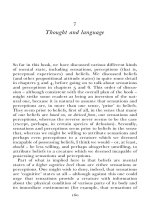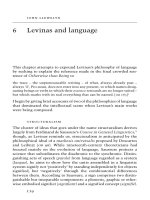Teaching Culture and Language
Bạn đang xem bản rút gọn của tài liệu. Xem và tải ngay bản đầy đủ của tài liệu tại đây (443.54 KB, 30 trang )
Teaching
Culture and Language
Language is the roadmap of a culture. It tells you
where its people come from and where they are
going.
The limits of a language are the limits of my
world.
Those who know nothing of other languages
know nothing of their own or the world.
What do you think?
Culture is a difficult term to define, because it
includes so much. In your own words, how
would you define culture?
Explain the following statement as you
interpret it: language and culture are
inseparably intertwined.
Language & Culture are intertwined
All communicative acts have at least 3
components:
Information – some kind of message
Some kind of interaction (conveying /receiving
messages either face-to-face or at a distance),
And some kind of code or text (language, including
verbal, non-verbal, paralinguistic and visual
elements)
Speech Acts Social/Cultural Identity
Social/cultural identity depends on the
community/communities to which we belong
and impact how we converse (Apologies,
polite requests, compliments, expression of
regrets, opinions, disagreements).
Identity is shaped by gender, age, ethnicity,
race, socio-economic status, education, power
status in the social hierarchy, religious beliefs
…
Teaching Culture
Why do we need to integrate culture into the
curriculum?
Language leads to cross-cultural
understanding
Language and culture are inextricably linked
Students often approach target culture
phenomena from within their own native-
language cultural framework
How do you integrate language
and culture in teaching and
learning?
Teaching Culture
Why aren’t we integrating culture better?
Culture remains a “superficial aspect” of
language learning (Lange, 1999)
1. Lack of agreement over what aspects of
culture to teach
2. Little consensus on how teaching of
culture and language should be
integrated
3. Lack of time!?!
Teaching Culture – Some Problems
Many teachers don’t feel they can take
the time to teach culture; they believe
students will be exposed to culture later
on
Some teachers are afraid to teach culture
because they feel they don’t know
enough about it
Teaching culture involves dealing with
student attitudes
Teaching Culture –
Some Common Approaches
Frankenstein Approach: a taco from here,
a bullfight from there
4-F Approach: folk dances, festivals, fairs,
food
Tour Guide Approach: identification of
monuments, rivers, cities
By-the-Way Approach: sporadic lectures,
bits of behavior to emphasize sharp
differences
Culture: Definitions etc. (1)
Brooks (1971) “Hearthstone culture”:
beliefs, behaviors, values [this became
known as “little-c”]
Brooks (1975) “Olympian culture”: great
music, literature, art [this became known
as big-C]
Seelye (1993) “all aspects of human life,
from folktales to carved whales” =
Olympian + Hearthstone culture
Culture and Instructional goals
Develop interest in another culture/
empathy toward people
Show that speaking/behavior is affected by
social variables
Help students realize that people think, act,
react in response to culturally conditioned
images
Show that behavior is shaped by situational
variables and conventions of the culture
Explore the culture from a variety of
sources
Developing a Cultural Awareness
“Balance” – big C & little c, artistic & scientific,
gender-related issues, socio-economic, rural &
urban
Dangers: ethnocentrism & bias
“Sins of commission”
Stereotyping: exaggerating some
aspect/characteristic of a culture or its people
Triviality: reducing the dizzying variety of
cultural elements to the silly, out of date,
quaint
Political bias: select elements of culture while
ignoring others
Models for Cross-Cultural
Understanding
Galloway (1984): framework based on process skills
1. Convention: recognize, understand how people
typically behave in everyday situations
2. Connotation: culturally significant meanings
associated with words
3. Conditioning: people act in a manner consistent
with their cultural frame of reference
4. Comprehension: analysis, hypothesis formation,
tolerance of ambiguity (examine stereotypes)
Strategies for Incorporating Culture
Consider the purpose for the activity
Consider its usefulness in teaching language and
culture in an integrated way
Plan carefully
Present culture with related thematic units and
grammatical content
Use a variety of techniques (speaking, listening,
reading, writing)
Use a variety of resources
Strategies for Incorporating Culture
Use cultural information when teaching
vocabulary
Use small group techniques (discussion,
brainstorming…) for cultural instruction
Avoid a “facts only” approach
Use the target language whenever possible
Test cultural understanding carefully
Teaching culture / understanding
cultural practices
1. 1. The Lecture
Most common technique
Keep it brief!
Liven it with visuals / technology
Focus on a specific aspect
Keep students accountable by having them take
notes
Use follow-up activities
Make it interactive
Teaching culture / understanding cultural
practices
2. Native Speakers
Valuable resources (current info,
linguistic models)
Helps to build community
Informal dialogue works better than
formal presentations
Meaningful context / real stories
Teaching culture / understanding cultural
practices
3. Audiotaped Interviews
Informal interviews with native speakers
Develop pre- & post- listening materials
Write brief summary of interview
Develop follow-up activities
Teaching culture / understanding cultural
practices
4. Videotaped Interviews / Observational
Dialogues
Natural, authentic linguistic exchanges
Can demo conventional gestures, eye contact,
social distance, etc.
Exchange video tapes with a school, bring in a
native speaker via video tape
5. Using Readings
Galloway’s (1992) 4 Step Approach to
cultural reading of authentic materials
1. Thinking – pre-reading tasks
2. Looking – orient students to text
3. Learning – examine various cross-
cultural contrasts
4. Integrating – reflection & integration
Teaching culture / understanding
cultural practices
Teaching culture / understanding
cultural practices
7. Culture Capsules: short description of one
minimal difference between an American and
a target culture custom (along with photos…)
Teaching culture / understanding cultural
practices
8. Culture Clusters: three illustrated culture
capsules that develop related topics plus one
30 minute simulation, integrating info into
capsules and dramatizing it through a skit or
role play
Teaching culture / understanding
cultural practices
9. Culture Assimilators: many different critical
incidents or episodes that take place between
an American and TC member with some type
of conflict or misinterpretation; students
presented with explanation of source of
conflict; students choose an explanation and
receive feedback
Teaching culture / understanding
cultural practices
10. Culture Minidramas: three to five
episodes in which a cultural conflict or
miscommunication occurs; students attempt
to explain the source of miscommunication
11. Technology Investigations, Projects, Role
Playing, Simulations









